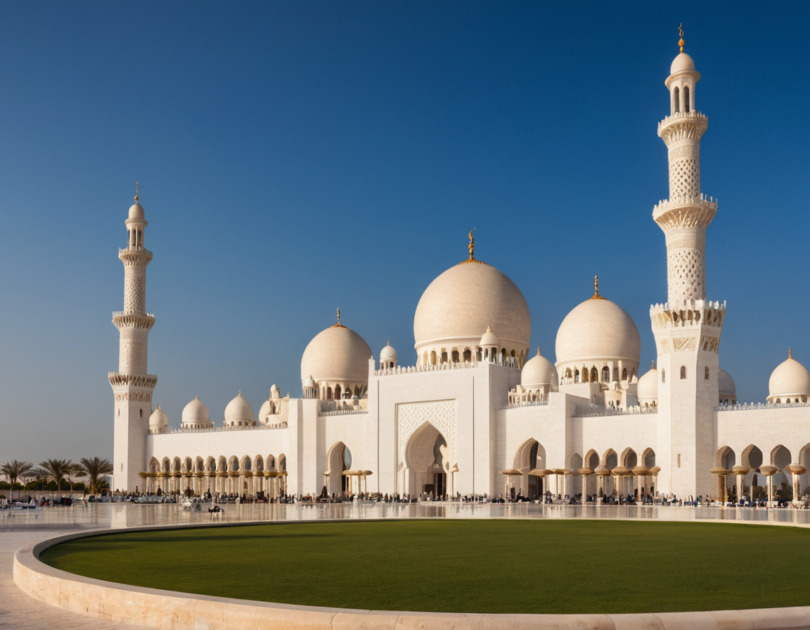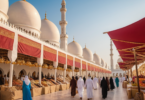Abu Dhabi, the vibrant capital of the United Arab Emirates, offers an exquisite blend of modernity and tradition. The city is home to some of the most iconic and culturally significant landmarks in the Gulf region. From towering skyscrapers to serene mosques, Abu Dhabi’s rich heritage is deeply embedded in every corner of the city. This article will guide you through the must-see cultural landmarks that define the heart and soul of this incredible destination.
1. Sheikh Zayed Grand Mosque: A Masterpiece of Islamic Architecture
The Sheikh Zayed Grand Mosque is undoubtedly one of the most iconic landmarks in Abu Dhabi. As one of the largest mosques in the world, it stands as a testament to the UAE’s cultural and religious heritage. This architectural marvel is known for its stunning white marble exterior, intricate carvings, and breathtaking chandeliers.
Visitors to the mosque are greeted by four towering minarets and over 80 domes, each adorned with intricate designs inspired by Islamic art. The interior of the mosque is equally impressive, featuring the world’s largest hand-knotted carpet and one of the largest chandeliers ever created. It is a place where the past meets the present, making it a must-visit for anyone exploring Abu Dhabi’s cultural heritage.
2. Qasr Al Hosn: The Oldest Stone Building in Abu Dhabi
For those interested in exploring the roots of Abu Dhabi’s history, Qasr Al Hosn is an essential stop. As the oldest stone building in the city, this fort has stood for over two centuries. Originally constructed in the 18th century, it served as the residence of the ruling family and the center of government for many years.
Today, Qasr Al Hosn is a cultural museum that offers a deep dive into the history and traditions of Abu Dhabi. The museum showcases artifacts, photographs, and exhibitions that tell the story of the city’s development and its leadership over the centuries. The fort’s unique blend of traditional and modern elements makes it a fascinating landmark for visitors of all ages.
3. The Louvre Abu Dhabi: A Bridge Between Cultures
The Louvre Abu Dhabi is a symbol of the UAE’s commitment to cultural exchange and dialogue. This world-class museum is a collaboration between the UAE and France and features an extensive collection of art and artifacts from around the globe. Designed by renowned architect Jean Nouvel, the museum’s striking dome appears to float above the gallery spaces, creating a captivating interplay of light and shadow.
Inside, visitors will find an eclectic mix of artwork spanning centuries and civilizations. From ancient Egyptian artifacts to European masterpieces, the Louvre Abu Dhabi offers an unparalleled opportunity to experience the world’s artistic legacy in one place. The museum’s commitment to fostering cross-cultural understanding makes it a cornerstone of Abu Dhabi’s cultural landscape.
4. Heritage Village: A Glimpse Into Traditional Emirati Life
If you want to experience Abu Dhabi’s heritage in a more immersive way, the Heritage Village is a must-see. Located along the Corniche, this recreated traditional village offers a fascinating glimpse into the life of the UAE’s Bedouin ancestors. The village is designed to reflect the way of life before the discovery of oil, showcasing traditional houses, craft workshops, and a bustling souk (marketplace).
Visitors can explore a variety of exhibits, including displays of traditional Emirati clothing, tools, and household items. The Heritage Village also features a museum with artifacts from the UAE’s past, providing a deeper understanding of the region’s history and cultural evolution.
5. Al Ain Oasis: A UNESCO World Heritage Site
For a unique experience that connects visitors to the agricultural roots of the UAE, Al Ain Oasis is an exceptional destination. Located in the city of Al Ain, which is just a short drive from Abu Dhabi, this UNESCO World Heritage site is home to an ancient irrigation system known as falaj. The oasis has been cultivated for over 3,000 years, and it remains one of the most important sources of date palms in the region.
The lush green environment of Al Ain Oasis is a stark contrast to the surrounding desert landscape, making it a tranquil and refreshing escape. Visitors can take a leisurely stroll along the shaded pathways, learning about the oasis’ rich agricultural history and the role it played in sustaining life in the region for centuries.
6. The Etihad Towers: Modern Architecture with Cultural Significance
While Abu Dhabi is known for its traditional landmarks, the Etihad Towers are an example of the city’s forward-thinking approach to architecture. These sleek, modern skyscrapers stand tall along the Corniche, with their futuristic design and impressive glass facades making them one of the most recognizable landmarks in the city.
The Etihad Towers are more than just a modern architectural feat; they also play an important cultural role. The towers house a variety of cultural spaces, including art galleries and exhibition centers, offering visitors a chance to experience contemporary Emirati art and culture. From their observation deck, visitors can enjoy breathtaking views of the city and the Arabian Gulf.
7. The Dubai-Al Ain Road and the Camel Race Track: Cultural Significance
For those who want to experience one of the UAE’s most ancient and beloved traditions, the Camel Race Track located on the outskirts of Abu Dhabi offers a unique opportunity to witness this cultural sport firsthand. Camel racing is a longstanding tradition in the UAE, and the race track is one of the premier venues in the country for this exhilarating event.
The track itself is part of the rich cultural heritage of the UAE and plays a significant role in preserving the tradition of camel racing. Visitors can attend races, learn about the history of the sport, and even participate in camel rides to get an authentic feel for this fascinating aspect of Emirati culture.
8. Al Bateen Shipyard: The Heart of Traditional Boatbuilding
Another must-see cultural landmark in Abu Dhabi is the Al Bateen Shipyard, a historic site where traditional wooden boats, known as dhows, are still crafted by hand. The shipyard has been a center of boatbuilding for centuries and remains one of the most important places in the UAE for preserving maritime traditions.
Visitors to the Al Bateen Shipyard can observe the intricate process of dhow construction, with skilled artisans using traditional tools and techniques passed down through generations. The shipyard also offers a glimpse into Abu Dhabi’s maritime history and the significant role dhows played in the region’s trade and exploration.
Conclusion: Abu Dhabi’s Cultural Tapestry
Abu Dhabi’s cultural landmarks are a reflection of its deep-rooted history and traditions, while also embracing the modernity that characterizes the city today. From the awe-inspiring Sheikh Zayed Grand Mosque to the historical Qasr Al Hosn fort, every site tells a unique story about the UAE’s evolution. Whether you are interested in Islamic architecture, ancient traditions, or contemporary art, Abu Dhabi offers something for every visitor to explore and appreciate. Make sure to add these must-see landmarks to your itinerary and experience the rich heritage of this captivating city.







